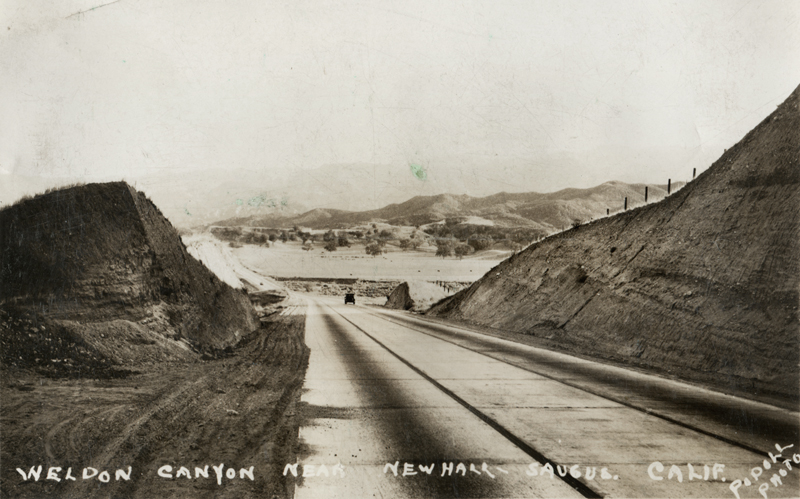|
|
U.S. Highway 99 | Newhall

Click image to enlarge Weldon Canyon on the new U.S. Highway 99, looking north toward the area that would become Valencia. Real photo postcard, 1930s. Front reads: Weldon Canyon Near Newhall-Saugus, Calif. On the back, in an unknown person's handwriting: "This is a view of Cal State Route 99 north of Los Angeles toward San Francisco looking north." From The Historic California US Highways site, authored by Casey Cooper: Before 1930, US 99, which incorporated the Ridge Route, followed the general route of Sierra Highway to its intersection with the "northern" San Fernando Road. Today, it is difficult imagine how these mountains were a major barrier to road construction, but it is important to bear in mind how significantly the construction of the two freeways altered them. Building a road which would provide more direct routing for US 99 was not possible until the late 1920s, when both road building technology and funding had sufficiently advanced to permit it. The Weldon Canyon bypass (officially known as the "Newhall Alternate"), which is now covered by I-5, was completed in 1930 and offered a substantial saving of time as well as increasing safety. Until its widening in 1951, this road was three lanes, with the suicide lane in the middle. North of the US 6 interchange, US 99 entered Weldon Canyon. Weldon Canyon is a stark contrast to the barren mountains that surround it and even though much of it has been paved over by present I-5, the lush vegetation that dotted its hillsides is still visible. Before 1928, this was a steep canyon, filled with vegetation reminiscent of someplace in the Pacific Northwest. The first road to cross it was only three lanes wide and hugged the western wall. It was widened into a four lane divided highway by 1953, but generally followed the previous alignment, which was engineered well enough to be incorporated into the newer highway. In fact, much of the widening work done in the 1940s and 1950s used the older alignments as half of the divided and widened road. The section between the I-5/SR-14 interchange and Lyons Ave was one of the last sections of US 99 to be replaced by I-5, having been bypassed between 1967 and 1972. Much of this highway still exists and is known today as The Old Road. Ridge Route history by Jerry Reynolds: Ever since the days of Phineas Banning, General Beale and the Butterfield Overland stage, vehicles made their way out of Los Angeles, through San Francisquito Canyon, down the Grapevine Pass, and then into Bakersfield. The California Highway Commission was formed in 1911, and one of its first priorities was to build a simpler, more direct road through the La Liebre Mountains. That task fell to the man with the unlikely name of W. Lewis Clark. Frustrated in several attempts to locate an easy way across the stony barrier, Clark, at last, blazed a trail right over the top from the mouth of Castaic Canyon to Gorman. It was called the Ridge Route. After a year of toil, during which four-horse Fresno scrapers graded hilltops alongside chugging Caterpillar tractors to the tune of a staggering half-million dollars, the Tejon Route, as it was originally dubbed, opened to the motoring public late in November 1915. The Auto Club did a little calculating, finding that in the 36 miles between Castaic and Gorman, there were 642 curves that added up to 97 complete circles. It did cut 60 miles off the road, however. Even before construction started in 1914, an enterprising businessman by the name of Sam Parsons purchased an acre of land from W.H. Cook fronting the stake line, then threw up a general store that catered to the needs of the workers. Afterwards, "Sam's Place" became a mecca for truckers and the beginning of a new town called Castaic.[...] While the Ridge Route did not bring permanent residents (to the Santa Clarita Valley), for the most part it did cut down on travel time to the great markets of Los Angeles. One could journey to town and back in a single day — amazing! Then there was the increasing horde of gentlemen clad in long linen dusters with goggles, piloting their chugging, spitting vehicles with names such as Marmon "41," Winton "Six," or Packard ("Ask the man who owns one"). They, their womenfolk, and children might get hungry along the way or need gasoline or automobile repairs. So began a series of what might be called "tourist traps." [...] The next stop (after Newhall-Saugus) along the Ridge Route would have been Castaic, (and then) there was the Ridge Road Garage, The Tumble Inn, Reservoir Summit, and that splendid establishment in the wilderness known as Sandberg. Local rancher Herman Sandberg provided excellent, guaranteed-fresh steaks at his hotel. Slot machines could also be found there and, in a long, low building out back (known as "The Crib,") feminine companionship was available for weary truckers and lonely salesmen. [...] In 1933 Highway 99 was carved up the canyons, bypassing the 18-year-old Ridge Route, which was already antiquated.
LW2413: 9600 dpi jpeg from original RPPC purchased by Leon Worden. |
The site owner makes no assertions as to ownership of any original copyrights to digitized images. However, these images are intended for Personal or Research use only. Any other kind of use, including but not limited to commercial or scholarly publication in any medium or format, public exhibition, or use online or in a web site, may be subject to additional restrictions including but not limited to the copyrights held by parties other than the site owner. USERS ARE SOLELY RESPONSIBLE for determining the existence of such rights and for obtaining any permissions and/or paying associated fees necessary for the proposed use.

